The Lichenophanes Lesne, 1899 of the Palaearctic and Oriental Regions (Coleoptera, Bostrichidae) †
Simple Summary
Abstract
1. Introduction
2. Materials and Methods
3. Results
3.1. General Information on the Genus Lichenophanes Lesne, 1899
3.2. Diagnosis, Description, and Biology of the New Species
- Lichenophanes juxtaorientalis Borowski and Brustel n. sp. (Figure 2A).
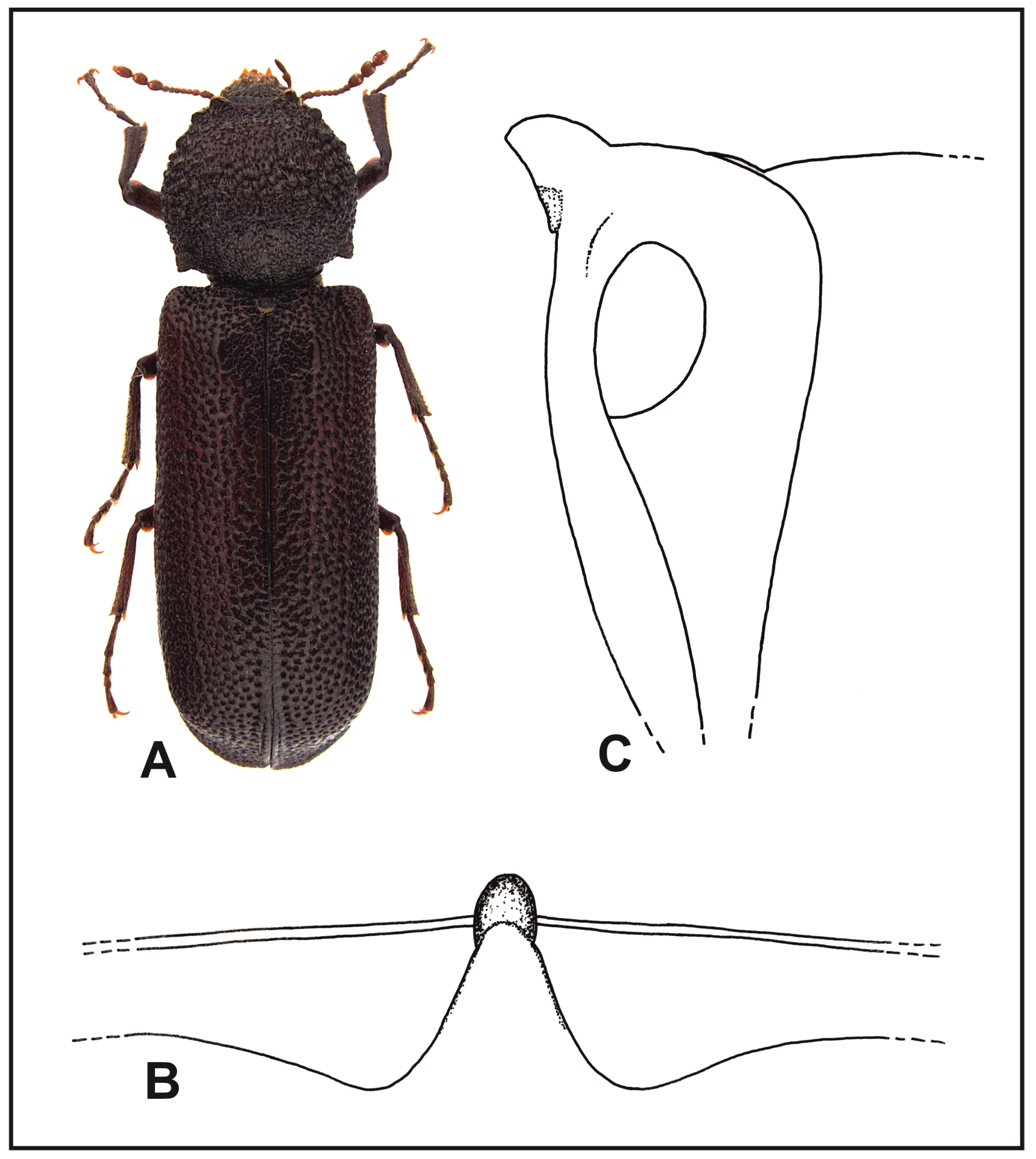
3.3. Lichenophanes varius (Illiger, 1801)
- Apate varia Illiger, 1801: 172 [7]
- Bostrichus Dufourii Laterille, 1806: 7 [8]
- Apate gallica Panzer, 1807: 17 [9]
3.3.1. Description, Biology, and Geographical Distribution of the Nominotypical Subspecies
- Lichenophanes varius varius (Illiger, 1801) (Figure 3A).
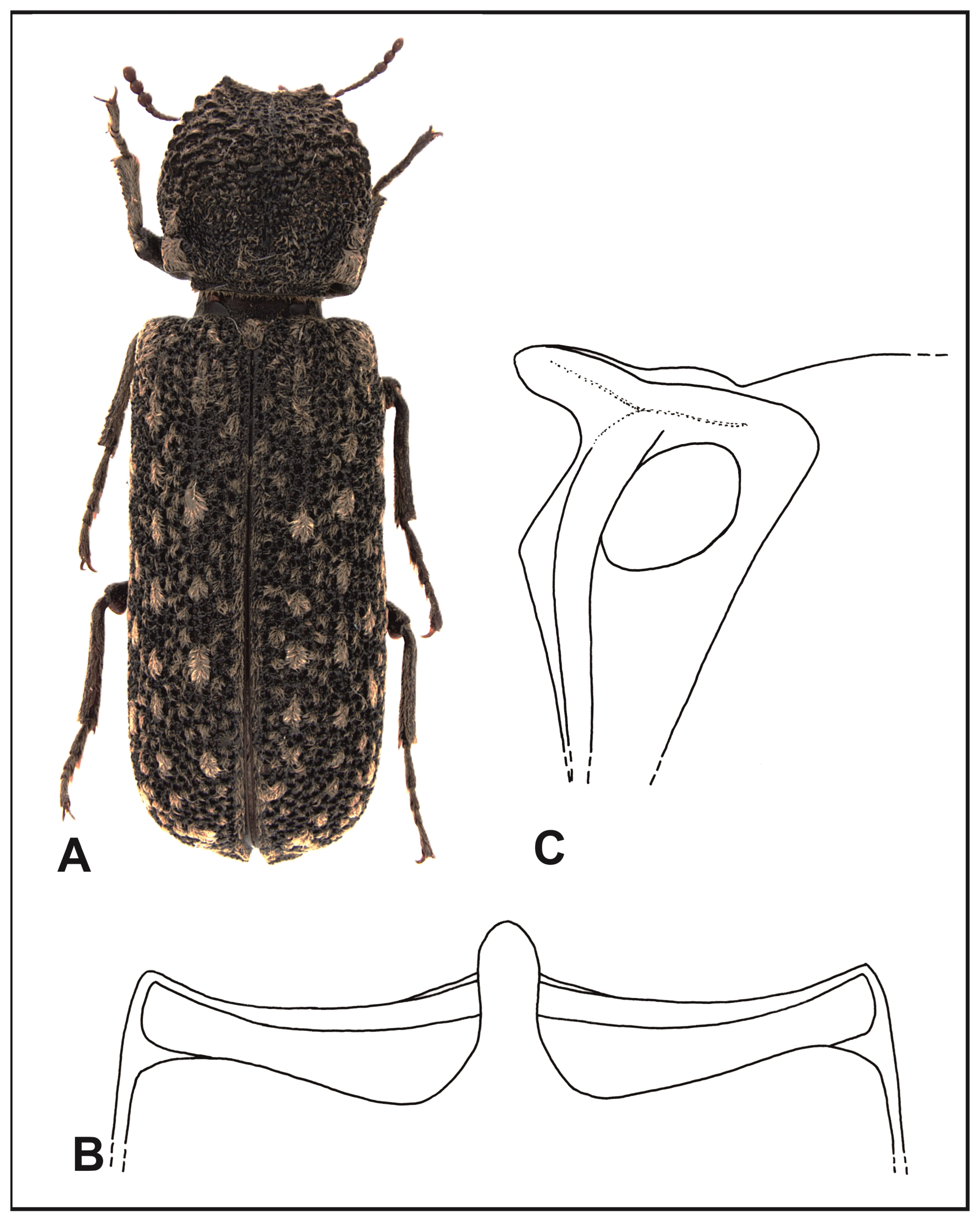
3.3.2. Diagnosis, Description, Biology, and Zoological Distribution of the New Subspecies
- Lichenophanes varius turanicus Borowski and Brustel n. subsp. (Figure 5A).
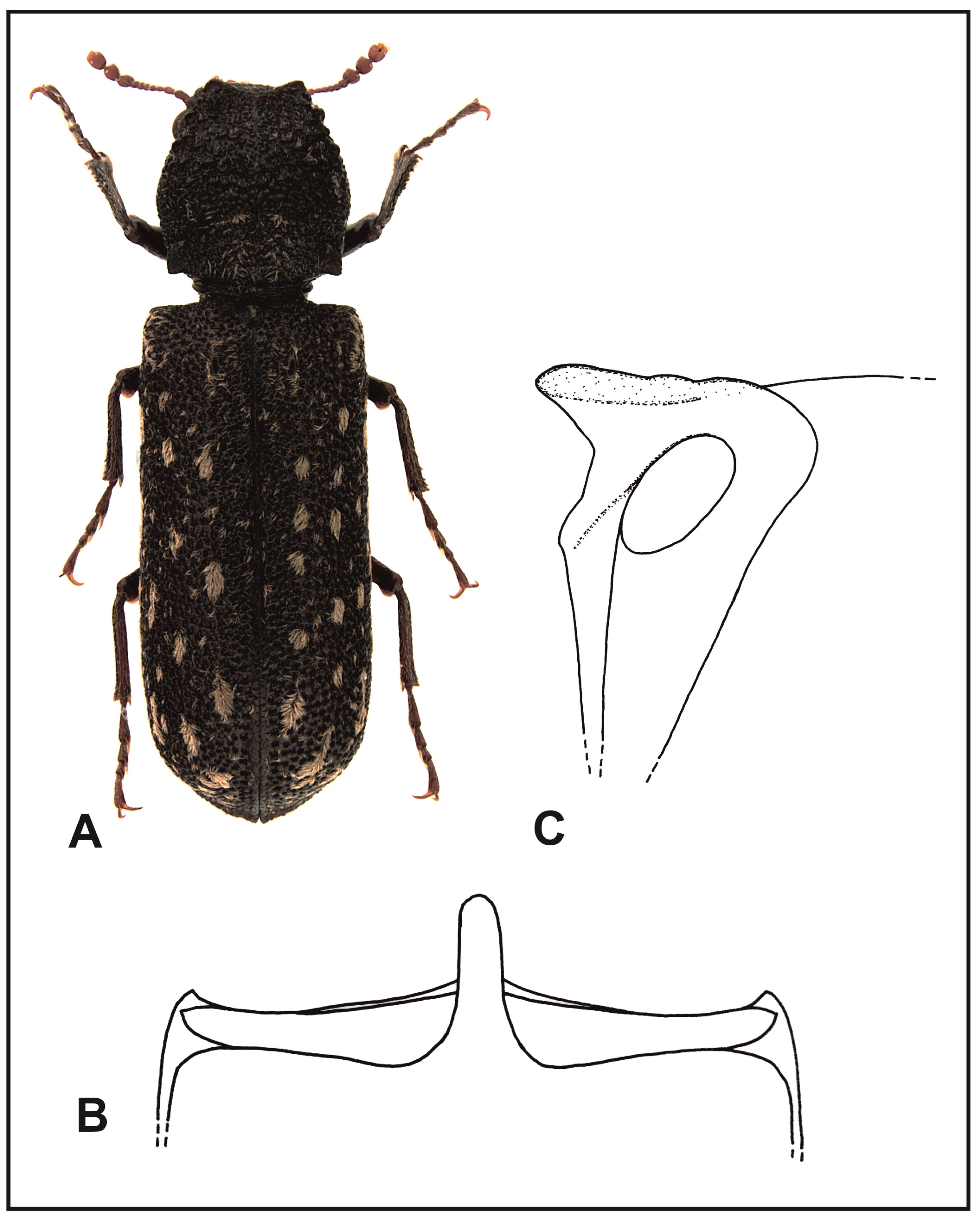
3.4. Diagnosis, Description, and Biology of Lichenophanes numida Lesne, 1899 (Figure 6)
- Lichenophanes numida Lesne, 1899: 478 [1].
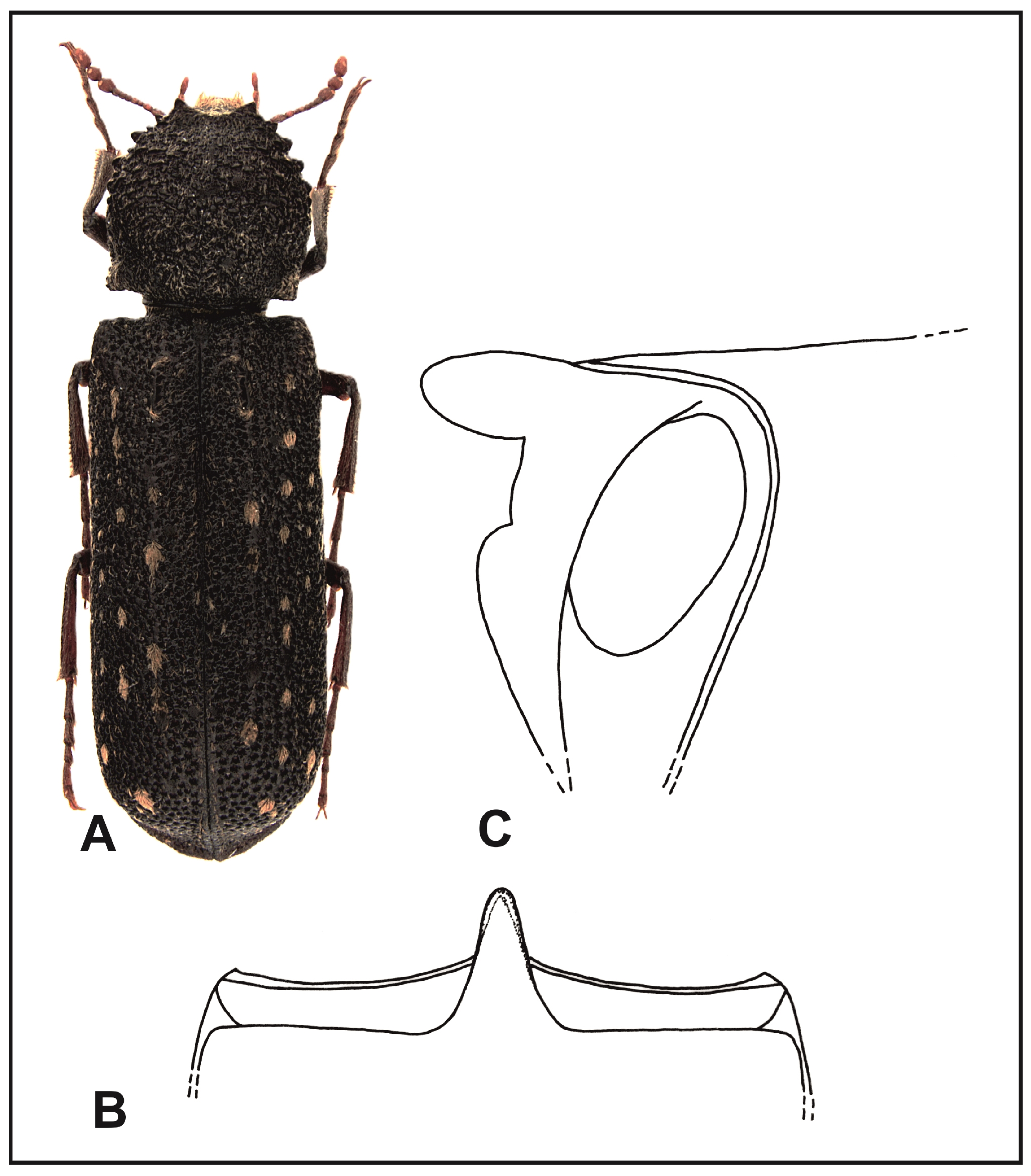
3.5. Description, Biology, and Geographical Distribution of Lichenophanes carinatus (Lewis, 1896) Stat. Rev. (Figure 7A)
3.6. Description, Biology, and Geographical Distribution of Lichenophanes carinipennis (Lewis, 1896) (Figure 9A)
4. Keys for Identifications
4.1. Key for the Identification of Western-Palaearctic Species of the Genus Lichenophanes
- Surface of elytra is covered with recumbent yellow, yellow–gray or golden setae, which form a marbled pattern.………………………………………………………………………………………………………………………2.
- -
- Surface of elytra almost naked; scarce, hardly noticeable, short, and recumbent setae on the sides and margins of elytra, and also in the area of elytral declivity…………………………………………………..L. juxtaorientalis n. sp.
- 2.
- Intercoxal process of the first abdominal sternite, conical in shape, evenly narrowing toward the apex, where it is narrowly rounded (Figure 6B); apical margins of elytra are slightly flattened and elongated toward the back……………………………………………………………………………………………..L. numida (Lesne).
- -
- 3.
- Surface of elytra is between punctures with tiny papillae; setae of elytra are dense and form numerous, wide patches that occur over nearly all their area……………………………………………….L. varius varius (Illiger).
- -
- Surface of elytra is between punctures without tiny papillae; setae of elytra form small, rarely distributed patches; the size and layout of patches resemble L. numida more than L. varius……..……L. varius turanicus n. subsp.
4.2. Key for the Identification of Eastern Asian Species of the Genus Lichenophanes
- Elytra at apices jointly sharpened (Figure 7C). Scape is as long as two subsequent segments. The first two segments of the club of antennae are rounded on the sides (Figure 7B). Areas between elytral punctures are narrow, and clearly narrower than the puncture diameter………………………………………L. carinatus (Lewis).
- -
- Elytral apices with short but clear declivity (Figure 9C). Scape is as long as the three subsequent segments. The first two segments of the club are straight on the sides (Figure 9B). Areas between elytral punctures are at least as wide as the puncture diameter or wider……………………………………………………….L. carinipennis (Lewis).
Author Contributions
Funding
Data Availability Statement
Acknowledgments
Conflicts of Interest
References
- Lesne, P. Revision des Coléoptéres de la famille des Bostrychides. Ann. Soc. Ent. Fr. 1899, 67, 438–621. [Google Scholar]
- Lesne, P. Bostrychidae. In Coleopterorum Catalogus Auspiciis et Auxilio, Pars 161; Junk, W., Schenkling, S., Eds.; Springer: Berlin/Heidelberg, Germany, 1938; pp. 1–84. [Google Scholar]
- Borowski, J. Bostrichidae. In Catalogue of Palaearctic Coleoptera. Vol. 4. Elateroidea—Derodontoidea—Bostrichoidea—Lymexyloidea—Cleroidea—Cucujoidea; Löbl, I., Smetana, A., Eds.; Apollo Books: Stenstrup, Denmark, 2007; pp. 320–328. [Google Scholar]
- Borowski, J.; Węgrzynowicz, P. World Catalogue of Bostrichidae (Coleoptera); Mantis: Olsztyn, Poland, 2007; pp. 1–8. 247p. [Google Scholar]
- Fåhraeus, O.I. Coleoptera Caffrariae, annis 1838–1845 a J. A. Wahlberg collecta. Fam. Scolytidae, Paussidae, Bostrichidae et Cioidae. Öfver. Fin. Vet.-Soc. Förh. 1871, 28, 661–672. [Google Scholar]
- Chûjô, M. Family Bostrychidae, Family Lyctidae. In Fauna Nipponica. Class Insecta Coleopteroidea-Coleoptera Vol. 10(8)(7); Okada, Y., Ed.; Sanseido Printer: Tokyo, Japan, 1937; 103p. [Google Scholar]
- Illiger, J.K.W. Neue Insecten. Mag. Insekt. 1801, 1, 163–208. [Google Scholar]
- Latreille, P.A. Genera Crustaceorum et Insectorum Secundum Ordinem Naturalem in Familias Disposita, Iconibus Exemplisque Plurimis Explicata. Tomus Tertius; Amand Koenig, Parisiis et Argentorati: Paris, France, 1806; 258p. [Google Scholar]
- Panzer, W.G. Faunae Insectorum Germanicae Initia Oder Deutschlands Insecten, Heft 10; Felsecker: Nürnberg, Germany, 1807; 24 sheets, 24 pls. [Google Scholar]
- Jacquelin du Val, P.N.C. Manuel Entomologque. Genera des Coléoptères d’Europe Comprenant leur Classification en Familles Naturelles, la Description de tous les Genres, des Tableaux Synoptiques Destinés à Facilier L’étude, le Catalogue de Toutes les Espéces de Nombreux Dessins au Trait de Caractéres. Tome 3.—2e Partie. Buprestides, Throscides, Eucnémides, Élatérides, Cébrionides, Rhipicérides, Dascillides, Lampyrides, Téléphoridés, Malachiides, Clérides, Lyméxylonides, Ptinides, Anobiides, Sphindides, Apatides, Lyctides, Cisides; A. Deyrolle: Paris, France, 1861; pp. 89–240, 139–168, pls. 22–58. [Google Scholar]
- Duftschmid, C. Fauna Austriae, Oder Beschreibung der Österreichischen Insecten für Angehende Freunde der Entomologie; Dritter Theil. Kunst-, Musik- und Buchhandlung: Linz, Austria, 1825; 289p. [Google Scholar]
- Lesne, P. Coup d’œil sur la distribution géographique des Bostychides paléarctiques. L’Abeille 1902, 30, 126–132. [Google Scholar]
- Nardi, G.; Biscaccianti, A.B. New ltalian records of Lichenophanes varius (Illiger, 1801) (Coleoptera, Bostrichidae). Nat. Conserv. 2017, 19, 219–229. [Google Scholar] [CrossRef][Green Version]
- López-Colón, J.I. Los Bostrichidae Laterille, 1802 de la fauna de Marruecos (Coleoptera). Biocosm. Més. 2000, 16, 171–221. [Google Scholar]
- Lewis, G. On new Species of Coleoptera from Japan, and Notices of others. Ann. Mag. Nat. Hist. Zool. Bot. Geol. 1896, 17, 329–343. [Google Scholar] [CrossRef]
- Lesne, P. Contributions à la faune indo-chinoise. Ann. Soc. Ent. Fr. 1896, 65, 511–512. [Google Scholar]
- Matsumura, S. Konchu Bunruigaku. II; Tokyo, Japan, 1915; 316p, 20p. [Google Scholar]
- Chûjô, M. Illustration of the Japanese species of beetles belonging to the families Bostrychidae and Lyctidae. Ageha 1958, 6 (Suppl. S1), 1–15. [Google Scholar]
- Lesne, P. Synopsis des Bostrychides paléarctiques. L’Abeille 1901, 30, 73–104. [Google Scholar]
- Chûjô, M. Description of a new species of Bostrychidae (Coleoptera) and notices of some others. Trans. Nat. Hist. Soc. Form. 1936, 26, 407–410. [Google Scholar]
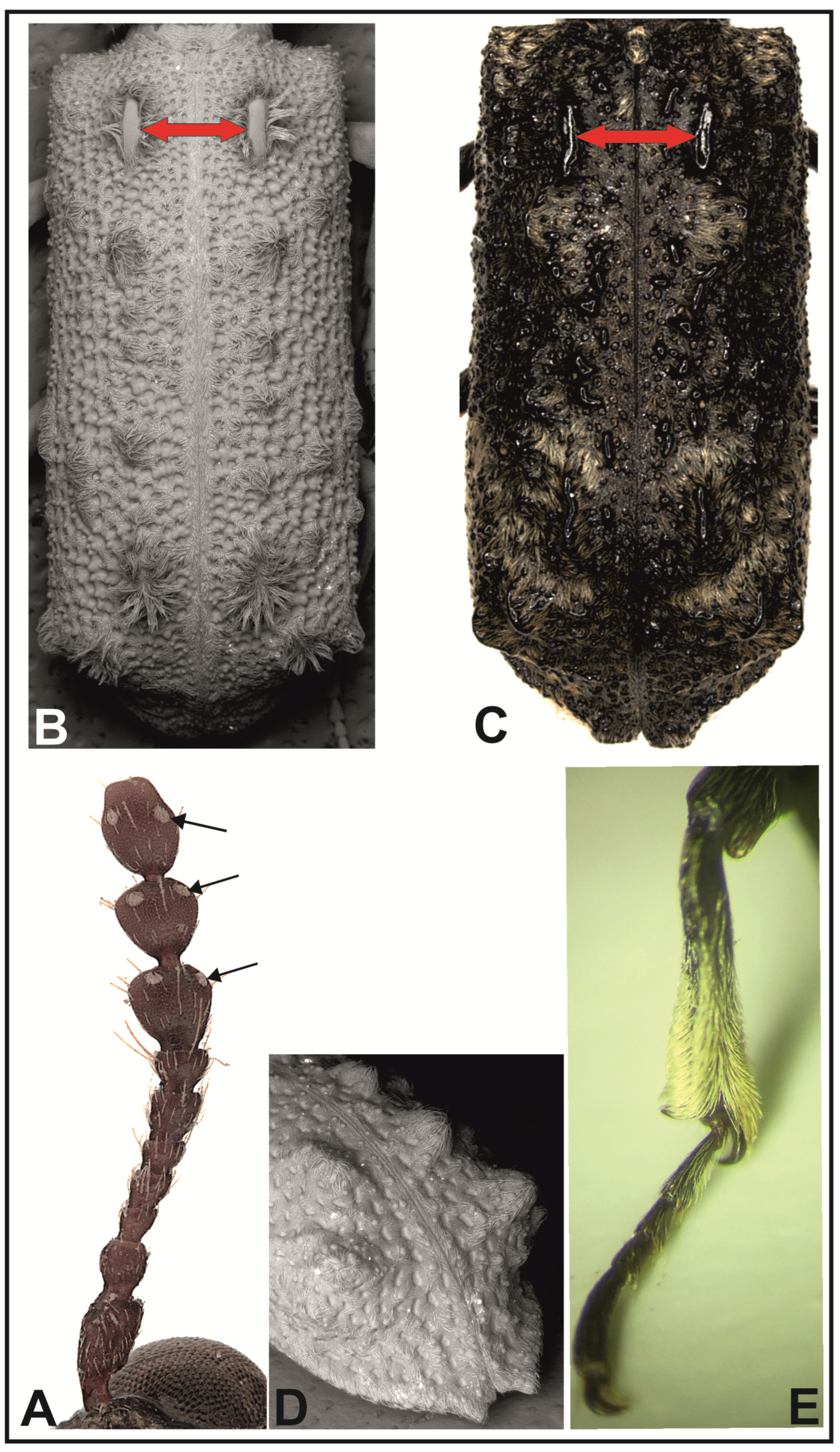
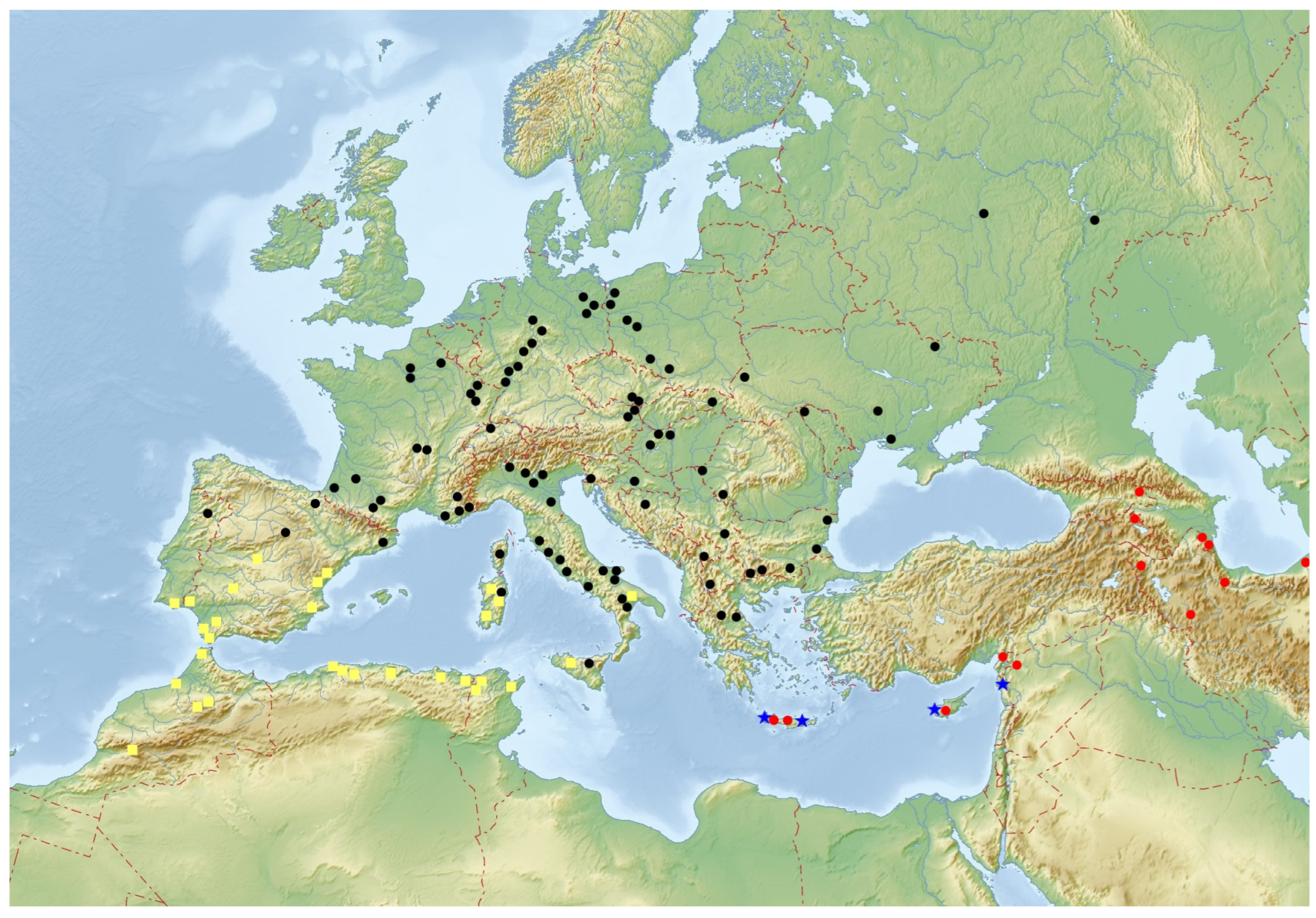

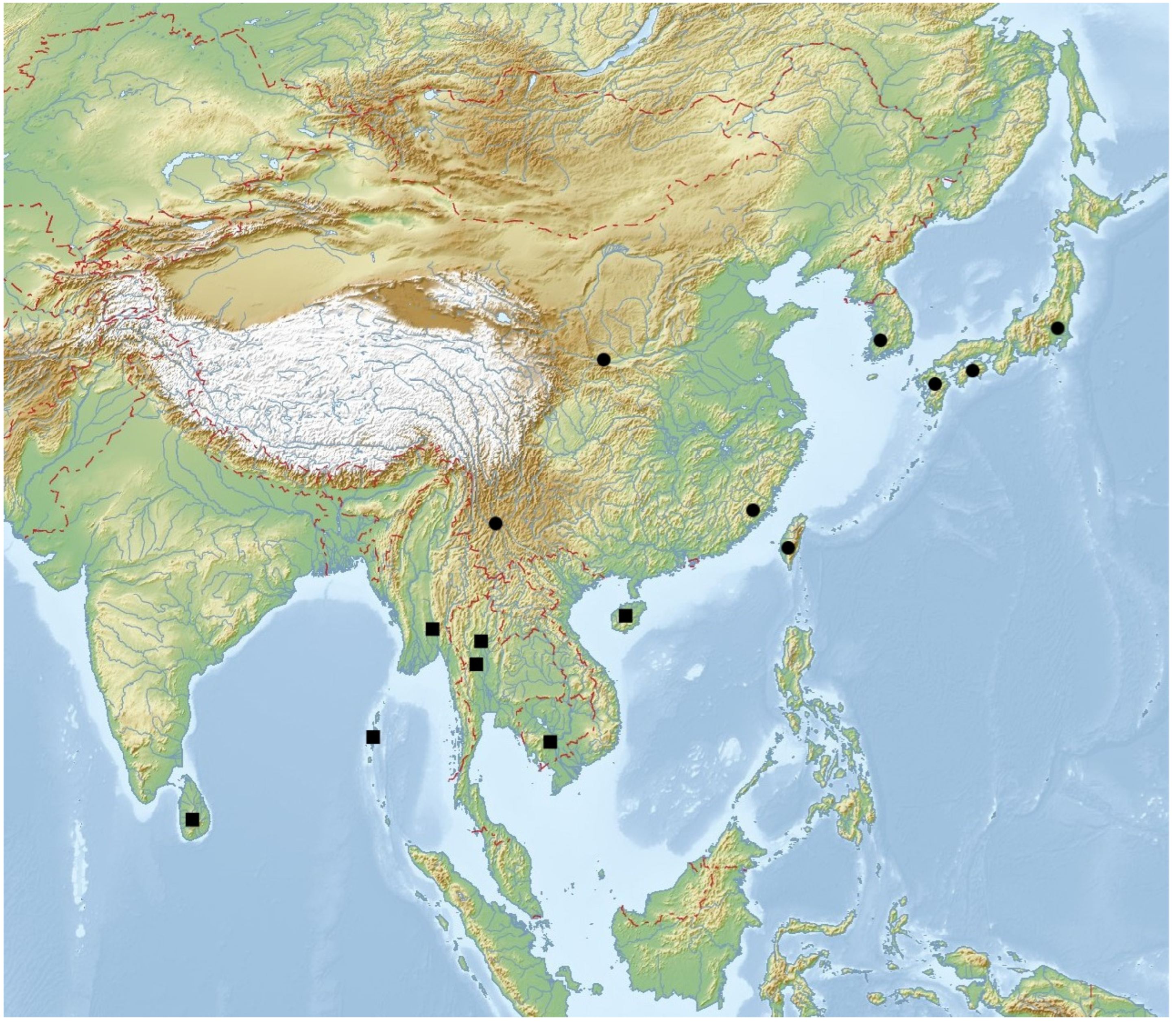
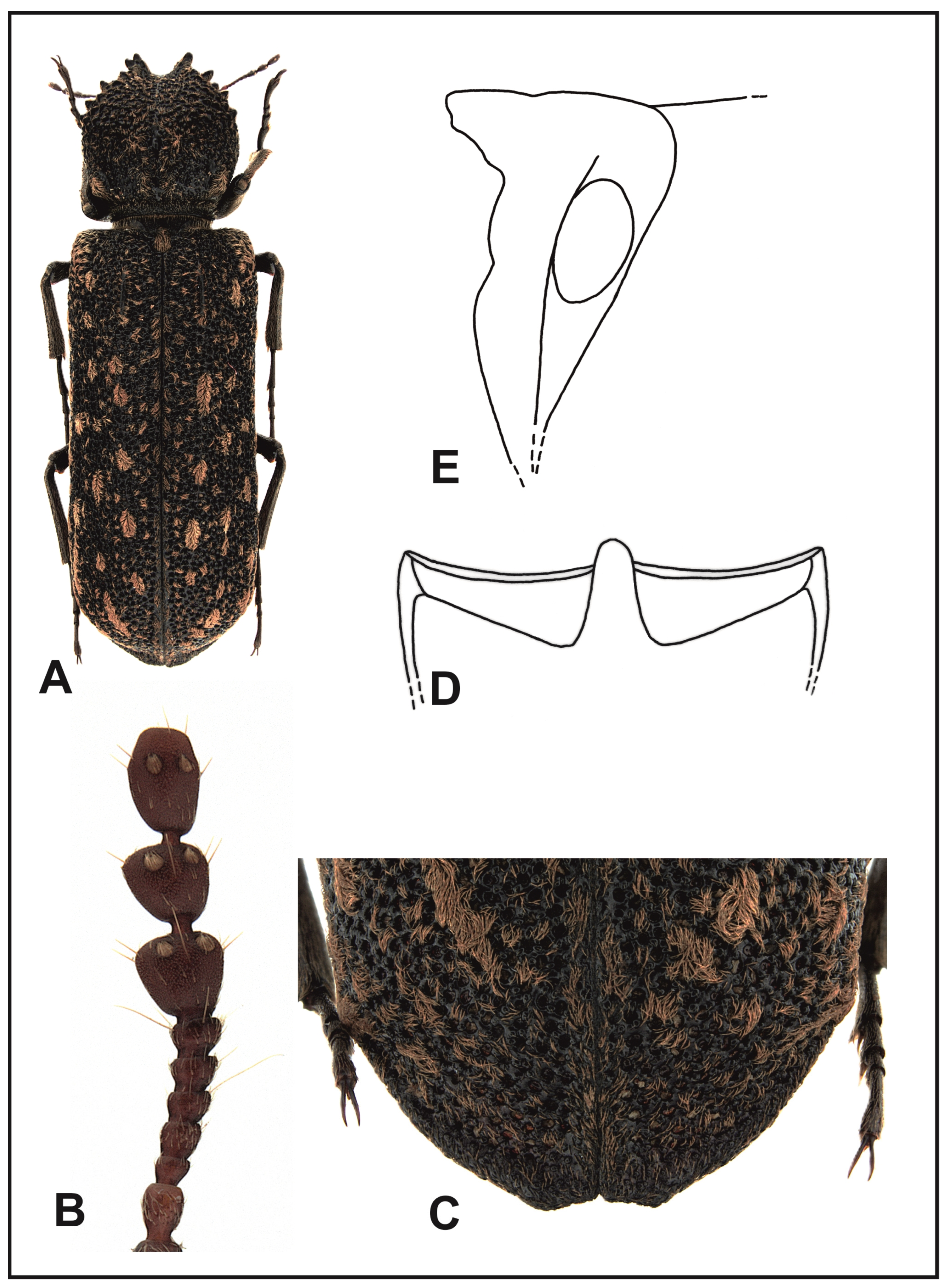
Disclaimer/Publisher’s Note: The statements, opinions and data contained in all publications are solely those of the individual author(s) and contributor(s) and not of MDPI and/or the editor(s). MDPI and/or the editor(s) disclaim responsibility for any injury to people or property resulting from any ideas, methods, instructions or products referred to in the content. |
© 2025 by the authors. Licensee MDPI, Basel, Switzerland. This article is an open access article distributed under the terms and conditions of the Creative Commons Attribution (CC BY) license (https://creativecommons.org/licenses/by/4.0/).
Share and Cite
Borowski, J.; Brustel, H.; Rutkiewicz, A.; Oszako, T.; Lasoń, A. The Lichenophanes Lesne, 1899 of the Palaearctic and Oriental Regions (Coleoptera, Bostrichidae). Insects 2025, 16, 411. https://doi.org/10.3390/insects16040411
Borowski J, Brustel H, Rutkiewicz A, Oszako T, Lasoń A. The Lichenophanes Lesne, 1899 of the Palaearctic and Oriental Regions (Coleoptera, Bostrichidae). Insects. 2025; 16(4):411. https://doi.org/10.3390/insects16040411
Chicago/Turabian StyleBorowski, Jerzy, Hervé Brustel, Artur Rutkiewicz, Tomasz Oszako, and Andrzej Lasoń. 2025. "The Lichenophanes Lesne, 1899 of the Palaearctic and Oriental Regions (Coleoptera, Bostrichidae)" Insects 16, no. 4: 411. https://doi.org/10.3390/insects16040411
APA StyleBorowski, J., Brustel, H., Rutkiewicz, A., Oszako, T., & Lasoń, A. (2025). The Lichenophanes Lesne, 1899 of the Palaearctic and Oriental Regions (Coleoptera, Bostrichidae). Insects, 16(4), 411. https://doi.org/10.3390/insects16040411






